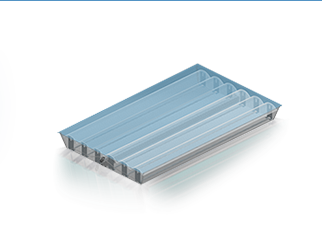The promise of solar energy is that, for all practical purposes, solar energy is unlimited and eternal (if the sun goes away, we go away). Despite this, only four percent of the world’s energy needs are supplied by solar resources today. Part of this is the relatively high cost of solar cells, their limited efficiency, and sometimes limited lifespans, which makes expensive replacements a regular necessity.
The total amount of solar energy striking the earth is a strikingly high figure, something in the way of terajoules, according to one site. About 1,000 Watts of energy hit every square meter of the earth’s surface, varying by the angle at which the surface is tilted relative to the parallel rays from the sun. Most solar cells fall into a 12-to-40-percent efficiency range, though, limiting a photovoltaic array’s output to about 120 to 400 watts per square meter (10.76 square feet) at the best angle.
That’s part of what makes solar aircraft problematical. Solar Impulse makes up for this lower overall energy capture by presenting huge surface areas to the sun. Almost all solar aircraft have a battery backup in their wings. Recharging in non-flying times or during slow cruise enables these craft to extract the extra power necessary for takeoff and climb. Large wings and tail surfaces provide the area to collect the energy, but the large wing area necessary to allow flight on limited power also limits the speed at which these craft can travel. But even 100-percent efficient cells would limit total energy available to about 10 kilowatts on a 100-square-foot wing, and that only if the sun were directly overhead.
A possible way to reduce the square footage required to generate sufficient energy may be found in a Small Business Innovation Research (SBIR) contract between Entech Solar, Inc., a Fort Worth, Texas based company and NASA’s Glenn Research Center. With similar designs using different materials, Entech is able to provide solar power to space ships or to utility-sized arrays for more terrestrial applications. The approach is in the process of being commercialized.
Using a concentrating photovoltaic (CPV) technology, sunlight can be focused to 20 times its normal intensity, reducing the silicon requirement for an energy output equivalent to non-concentrated flat-plate cells by 93 percent, according to the manufacturer. This smaller use of expensive materials allows low cost for large installations, an important factor for utilities.
The same linear lens forms are used in space applications, but cell and other materials are of a higher quality and therefore of a greater cost than their earth-bound counterparts. In many concentrating PV panels, heat buildup requires liquid cooling or a significant heat sink to keep things at a tolerable temperature. Entech claims that, “By using smaller lenses, the aluminum housing provides all waste heat rejection, eliminating the need for a heavy and expensive heat sink.”
Even with the small amount of silicon used, the panels produce electricity with 30-percent efficiency, according to Entech. This would certainly allow more power to electric aircraft if this technology can be adapted at a cost somewhere between utility-grade and space-grade panels.
You can review Entech’s specification sheet for their SolarVolt™ panels here.

